Internet of Things Heath Care - PDF
VerifiedAdded on 2021/01/02
|8
|1275
|232
AI Summary
Contribute Materials
Your contribution can guide someone’s learning journey. Share your
documents today.
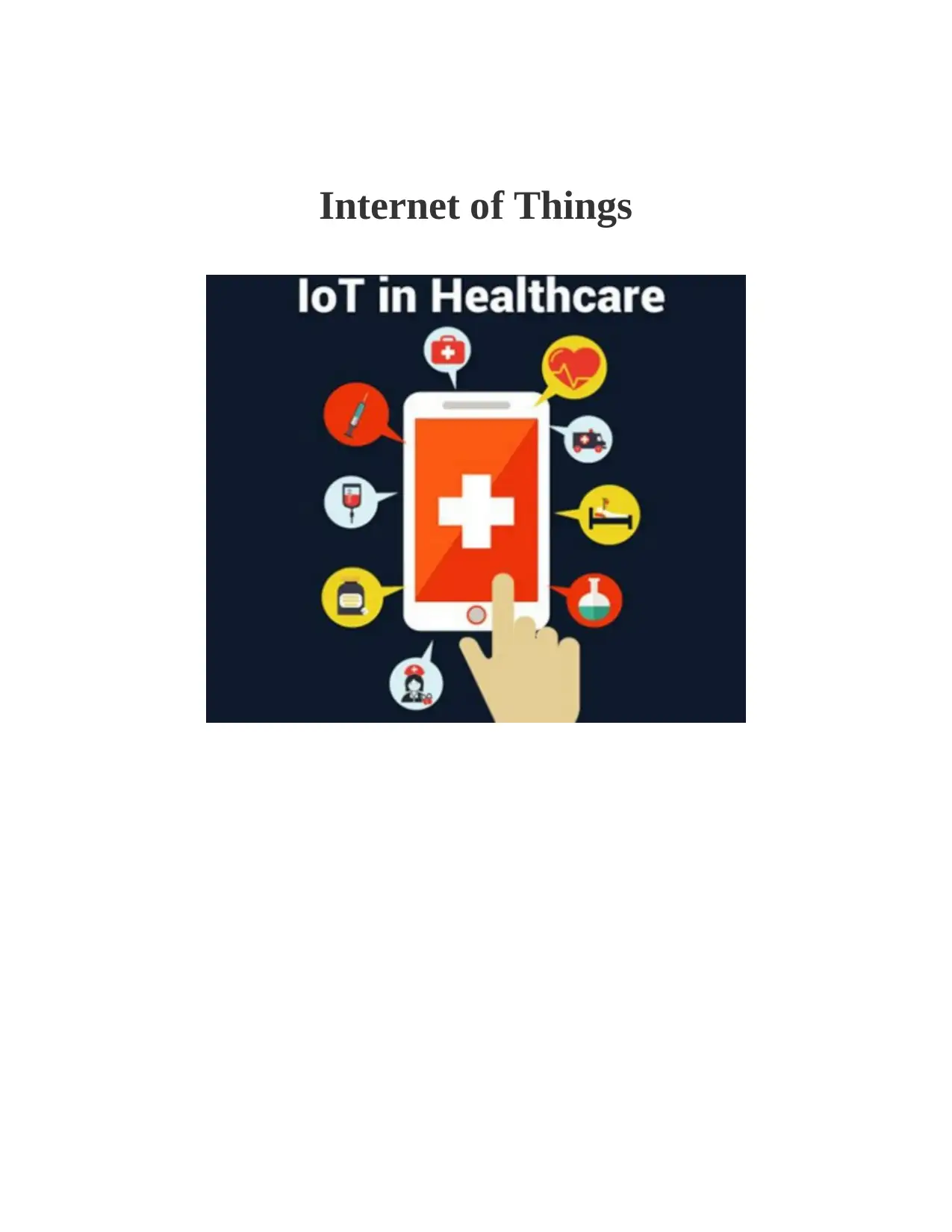
Internet of Things
Secure Best Marks with AI Grader
Need help grading? Try our AI Grader for instant feedback on your assignments.
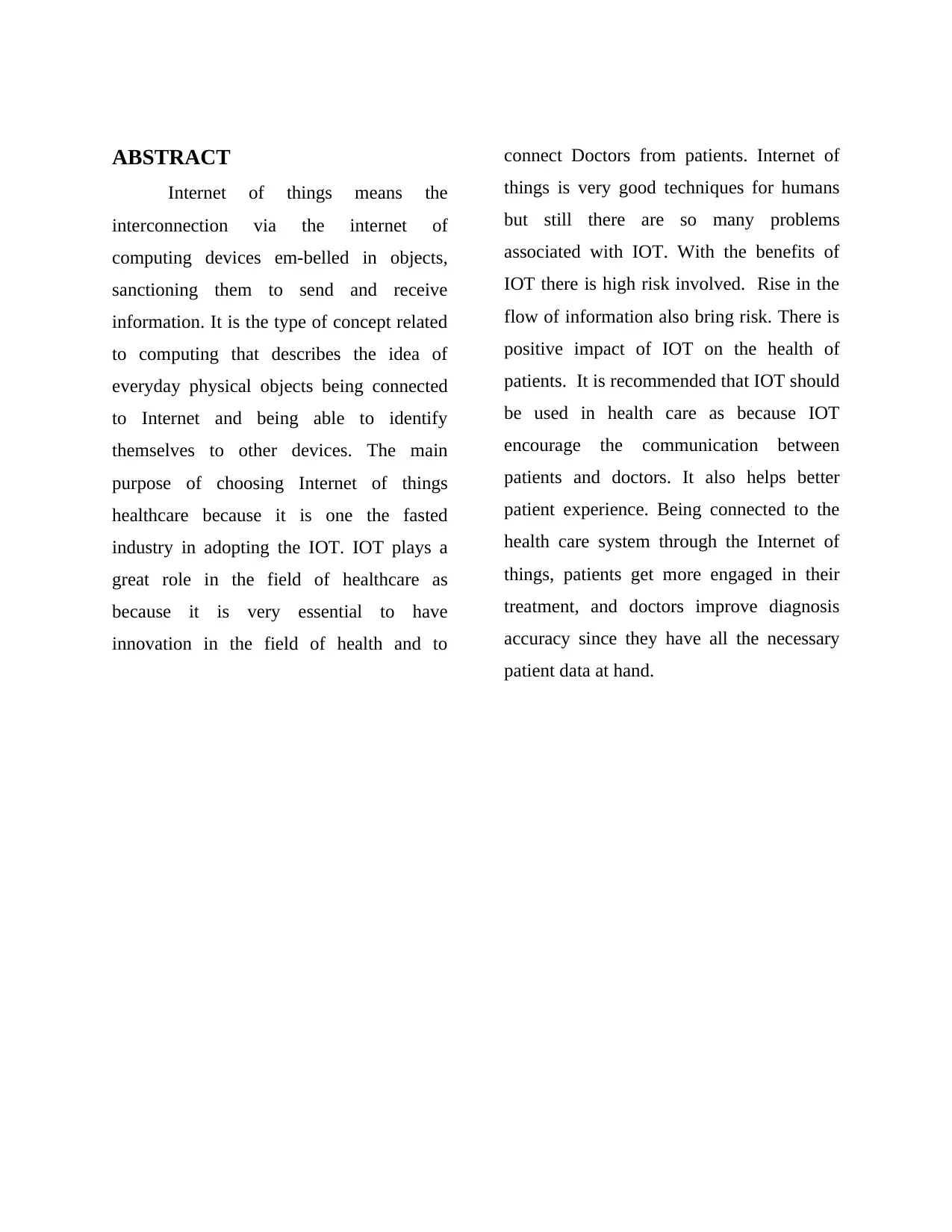
ABSTRACT
Internet of things means the
interconnection via the internet of
computing devices em-belled in objects,
sanctioning them to send and receive
information. It is the type of concept related
to computing that describes the idea of
everyday physical objects being connected
to Internet and being able to identify
themselves to other devices. The main
purpose of choosing Internet of things
healthcare because it is one the fasted
industry in adopting the IOT. IOT plays a
great role in the field of healthcare as
because it is very essential to have
innovation in the field of health and to
connect Doctors from patients. Internet of
things is very good techniques for humans
but still there are so many problems
associated with IOT. With the benefits of
IOT there is high risk involved. Rise in the
flow of information also bring risk. There is
positive impact of IOT on the health of
patients. It is recommended that IOT should
be used in health care as because IOT
encourage the communication between
patients and doctors. It also helps better
patient experience. Being connected to the
health care system through the Internet of
things, patients get more engaged in their
treatment, and doctors improve diagnosis
accuracy since they have all the necessary
patient data at hand.
Internet of things means the
interconnection via the internet of
computing devices em-belled in objects,
sanctioning them to send and receive
information. It is the type of concept related
to computing that describes the idea of
everyday physical objects being connected
to Internet and being able to identify
themselves to other devices. The main
purpose of choosing Internet of things
healthcare because it is one the fasted
industry in adopting the IOT. IOT plays a
great role in the field of healthcare as
because it is very essential to have
innovation in the field of health and to
connect Doctors from patients. Internet of
things is very good techniques for humans
but still there are so many problems
associated with IOT. With the benefits of
IOT there is high risk involved. Rise in the
flow of information also bring risk. There is
positive impact of IOT on the health of
patients. It is recommended that IOT should
be used in health care as because IOT
encourage the communication between
patients and doctors. It also helps better
patient experience. Being connected to the
health care system through the Internet of
things, patients get more engaged in their
treatment, and doctors improve diagnosis
accuracy since they have all the necessary
patient data at hand.
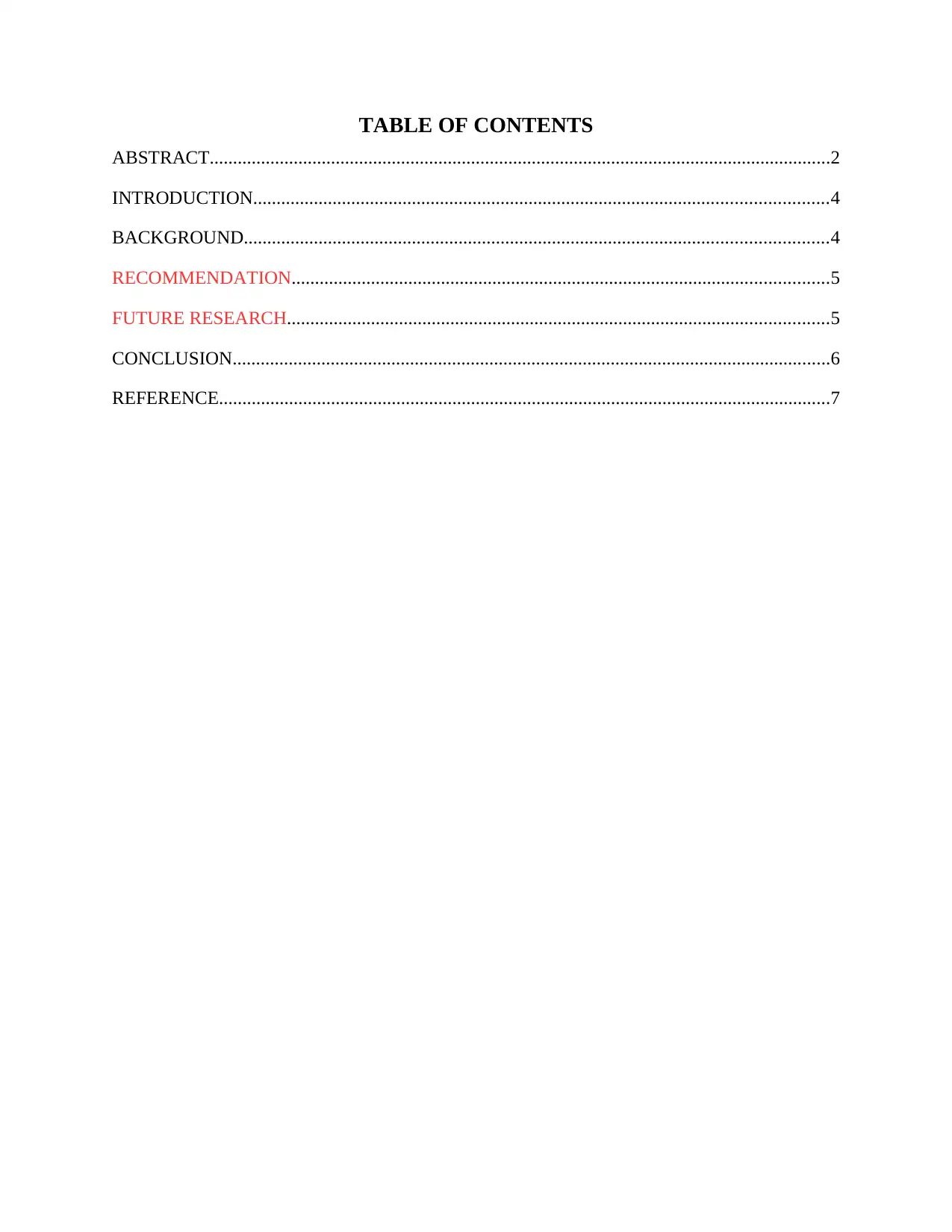
TABLE OF CONTENTS
ABSTRACT.....................................................................................................................................2
INTRODUCTION...........................................................................................................................4
BACKGROUND.............................................................................................................................4
RECOMMENDATION...................................................................................................................5
FUTURE RESEARCH....................................................................................................................5
CONCLUSION................................................................................................................................6
REFERENCE...................................................................................................................................7
ABSTRACT.....................................................................................................................................2
INTRODUCTION...........................................................................................................................4
BACKGROUND.............................................................................................................................4
RECOMMENDATION...................................................................................................................5
FUTURE RESEARCH....................................................................................................................5
CONCLUSION................................................................................................................................6
REFERENCE...................................................................................................................................7
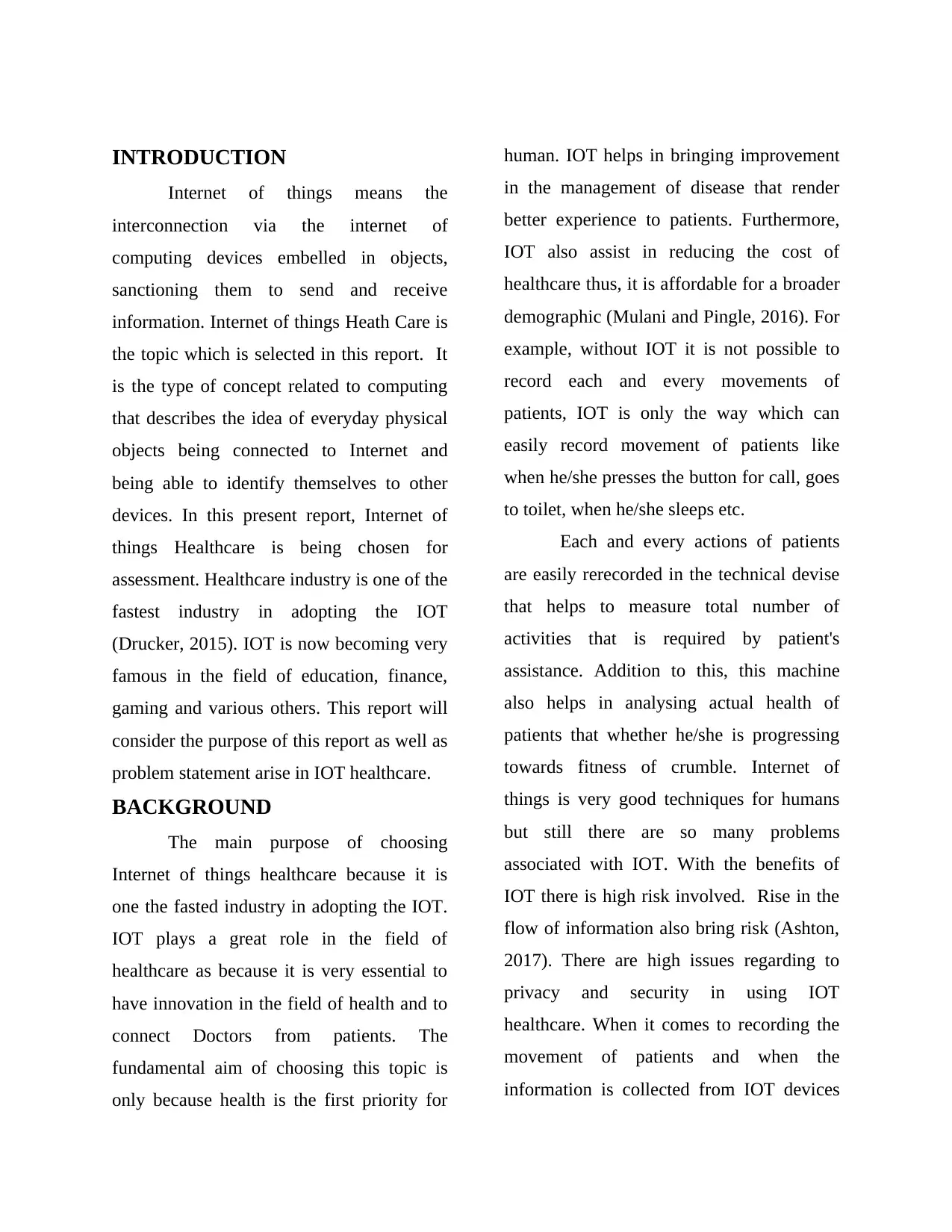
INTRODUCTION
Internet of things means the
interconnection via the internet of
computing devices embelled in objects,
sanctioning them to send and receive
information. Internet of things Heath Care is
the topic which is selected in this report. It
is the type of concept related to computing
that describes the idea of everyday physical
objects being connected to Internet and
being able to identify themselves to other
devices. In this present report, Internet of
things Healthcare is being chosen for
assessment. Healthcare industry is one of the
fastest industry in adopting the IOT
(Drucker, 2015). IOT is now becoming very
famous in the field of education, finance,
gaming and various others. This report will
consider the purpose of this report as well as
problem statement arise in IOT healthcare.
BACKGROUND
The main purpose of choosing
Internet of things healthcare because it is
one the fasted industry in adopting the IOT.
IOT plays a great role in the field of
healthcare as because it is very essential to
have innovation in the field of health and to
connect Doctors from patients. The
fundamental aim of choosing this topic is
only because health is the first priority for
human. IOT helps in bringing improvement
in the management of disease that render
better experience to patients. Furthermore,
IOT also assist in reducing the cost of
healthcare thus, it is affordable for a broader
demographic (Mulani and Pingle, 2016). For
example, without IOT it is not possible to
record each and every movements of
patients, IOT is only the way which can
easily record movement of patients like
when he/she presses the button for call, goes
to toilet, when he/she sleeps etc.
Each and every actions of patients
are easily rerecorded in the technical devise
that helps to measure total number of
activities that is required by patient's
assistance. Addition to this, this machine
also helps in analysing actual health of
patients that whether he/she is progressing
towards fitness of crumble. Internet of
things is very good techniques for humans
but still there are so many problems
associated with IOT. With the benefits of
IOT there is high risk involved. Rise in the
flow of information also bring risk (Ashton,
2017). There are high issues regarding to
privacy and security in using IOT
healthcare. When it comes to recording the
movement of patients and when the
information is collected from IOT devices
Internet of things means the
interconnection via the internet of
computing devices embelled in objects,
sanctioning them to send and receive
information. Internet of things Heath Care is
the topic which is selected in this report. It
is the type of concept related to computing
that describes the idea of everyday physical
objects being connected to Internet and
being able to identify themselves to other
devices. In this present report, Internet of
things Healthcare is being chosen for
assessment. Healthcare industry is one of the
fastest industry in adopting the IOT
(Drucker, 2015). IOT is now becoming very
famous in the field of education, finance,
gaming and various others. This report will
consider the purpose of this report as well as
problem statement arise in IOT healthcare.
BACKGROUND
The main purpose of choosing
Internet of things healthcare because it is
one the fasted industry in adopting the IOT.
IOT plays a great role in the field of
healthcare as because it is very essential to
have innovation in the field of health and to
connect Doctors from patients. The
fundamental aim of choosing this topic is
only because health is the first priority for
human. IOT helps in bringing improvement
in the management of disease that render
better experience to patients. Furthermore,
IOT also assist in reducing the cost of
healthcare thus, it is affordable for a broader
demographic (Mulani and Pingle, 2016). For
example, without IOT it is not possible to
record each and every movements of
patients, IOT is only the way which can
easily record movement of patients like
when he/she presses the button for call, goes
to toilet, when he/she sleeps etc.
Each and every actions of patients
are easily rerecorded in the technical devise
that helps to measure total number of
activities that is required by patient's
assistance. Addition to this, this machine
also helps in analysing actual health of
patients that whether he/she is progressing
towards fitness of crumble. Internet of
things is very good techniques for humans
but still there are so many problems
associated with IOT. With the benefits of
IOT there is high risk involved. Rise in the
flow of information also bring risk (Ashton,
2017). There are high issues regarding to
privacy and security in using IOT
healthcare. When it comes to recording the
movement of patients and when the
information is collected from IOT devices
Secure Best Marks with AI Grader
Need help grading? Try our AI Grader for instant feedback on your assignments.
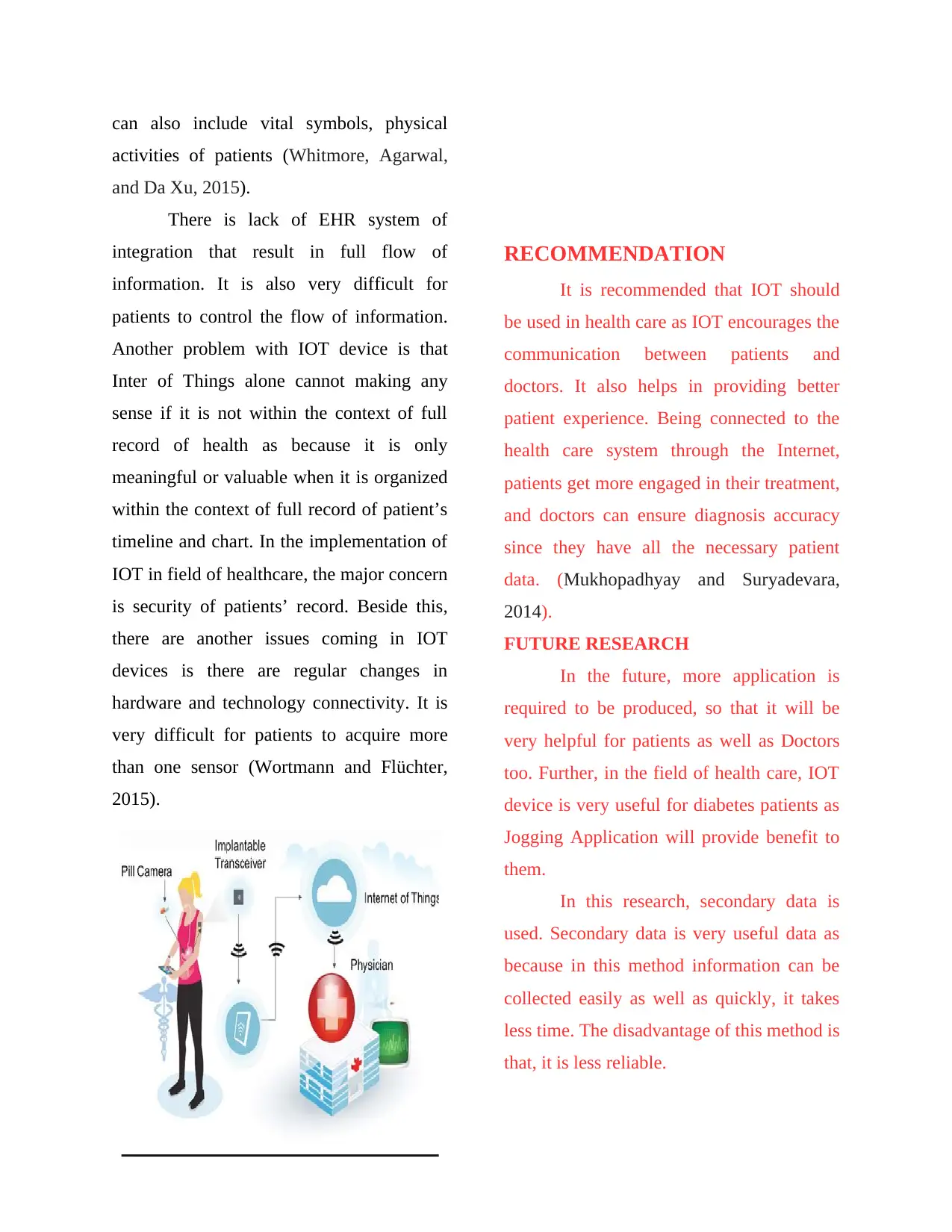
can also include vital symbols, physical
activities of patients (Whitmore, Agarwal,
and Da Xu, 2015).
There is lack of EHR system of
integration that result in full flow of
information. It is also very difficult for
patients to control the flow of information.
Another problem with IOT device is that
Inter of Things alone cannot making any
sense if it is not within the context of full
record of health as because it is only
meaningful or valuable when it is organized
within the context of full record of patient’s
timeline and chart. In the implementation of
IOT in field of healthcare, the major concern
is security of patients’ record. Beside this,
there are another issues coming in IOT
devices is there are regular changes in
hardware and technology connectivity. It is
very difficult for patients to acquire more
than one sensor (Wortmann and Flüchter,
2015).
RECOMMENDATION
It is recommended that IOT should
be used in health care as IOT encourages the
communication between patients and
doctors. It also helps in providing better
patient experience. Being connected to the
health care system through the Internet,
patients get more engaged in their treatment,
and doctors can ensure diagnosis accuracy
since they have all the necessary patient
data. (Mukhopadhyay and Suryadevara,
2014).
FUTURE RESEARCH
In the future, more application is
required to be produced, so that it will be
very helpful for patients as well as Doctors
too. Further, in the field of health care, IOT
device is very useful for diabetes patients as
Jogging Application will provide benefit to
them.
In this research, secondary data is
used. Secondary data is very useful data as
because in this method information can be
collected easily as well as quickly, it takes
less time. The disadvantage of this method is
that, it is less reliable.
activities of patients (Whitmore, Agarwal,
and Da Xu, 2015).
There is lack of EHR system of
integration that result in full flow of
information. It is also very difficult for
patients to control the flow of information.
Another problem with IOT device is that
Inter of Things alone cannot making any
sense if it is not within the context of full
record of health as because it is only
meaningful or valuable when it is organized
within the context of full record of patient’s
timeline and chart. In the implementation of
IOT in field of healthcare, the major concern
is security of patients’ record. Beside this,
there are another issues coming in IOT
devices is there are regular changes in
hardware and technology connectivity. It is
very difficult for patients to acquire more
than one sensor (Wortmann and Flüchter,
2015).
RECOMMENDATION
It is recommended that IOT should
be used in health care as IOT encourages the
communication between patients and
doctors. It also helps in providing better
patient experience. Being connected to the
health care system through the Internet,
patients get more engaged in their treatment,
and doctors can ensure diagnosis accuracy
since they have all the necessary patient
data. (Mukhopadhyay and Suryadevara,
2014).
FUTURE RESEARCH
In the future, more application is
required to be produced, so that it will be
very helpful for patients as well as Doctors
too. Further, in the field of health care, IOT
device is very useful for diabetes patients as
Jogging Application will provide benefit to
them.
In this research, secondary data is
used. Secondary data is very useful data as
because in this method information can be
collected easily as well as quickly, it takes
less time. The disadvantage of this method is
that, it is less reliable.
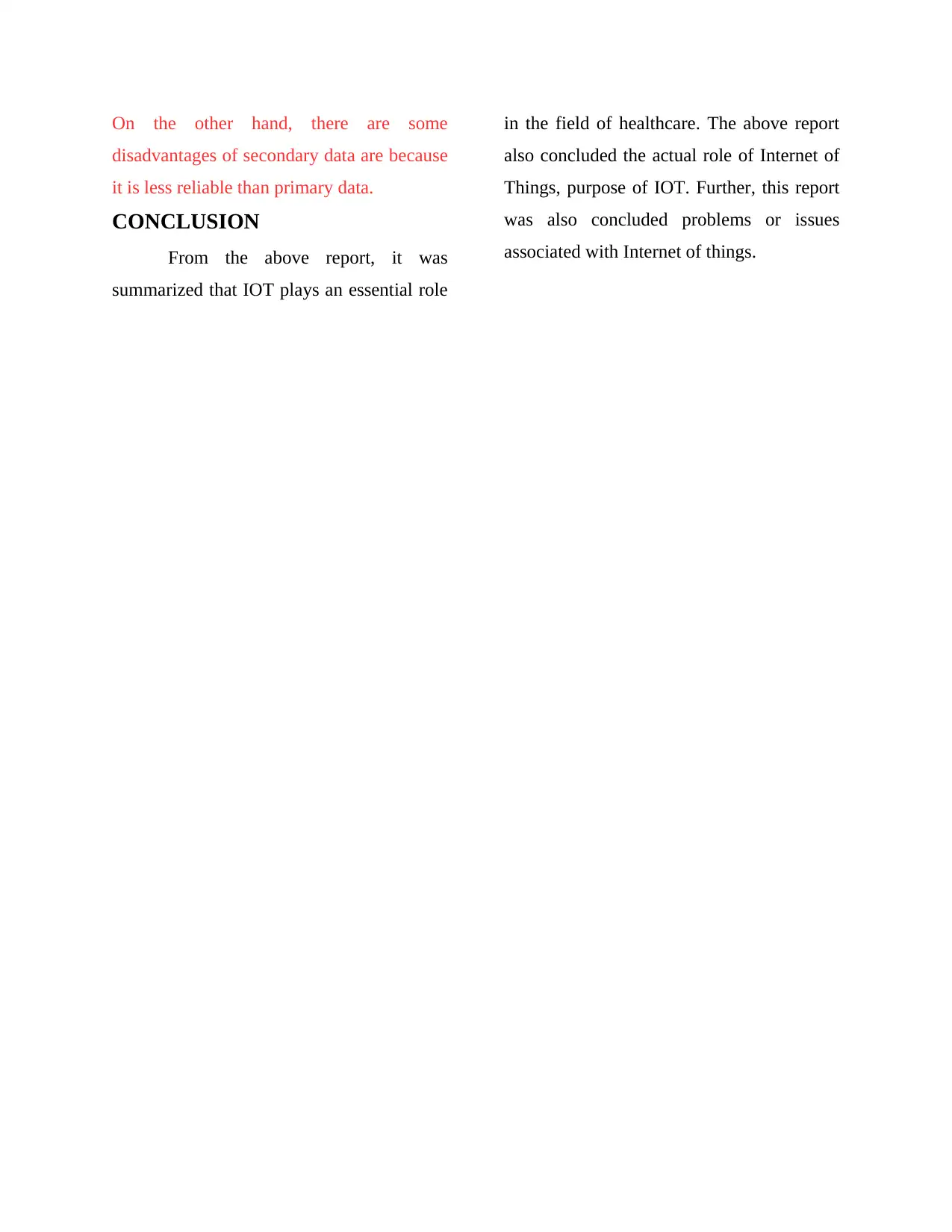
On the other hand, there are some
disadvantages of secondary data are because
it is less reliable than primary data.
CONCLUSION
From the above report, it was
summarized that IOT plays an essential role
in the field of healthcare. The above report
also concluded the actual role of Internet of
Things, purpose of IOT. Further, this report
was also concluded problems or issues
associated with Internet of things.
disadvantages of secondary data are because
it is less reliable than primary data.
CONCLUSION
From the above report, it was
summarized that IOT plays an essential role
in the field of healthcare. The above report
also concluded the actual role of Internet of
Things, purpose of IOT. Further, this report
was also concluded problems or issues
associated with Internet of things.
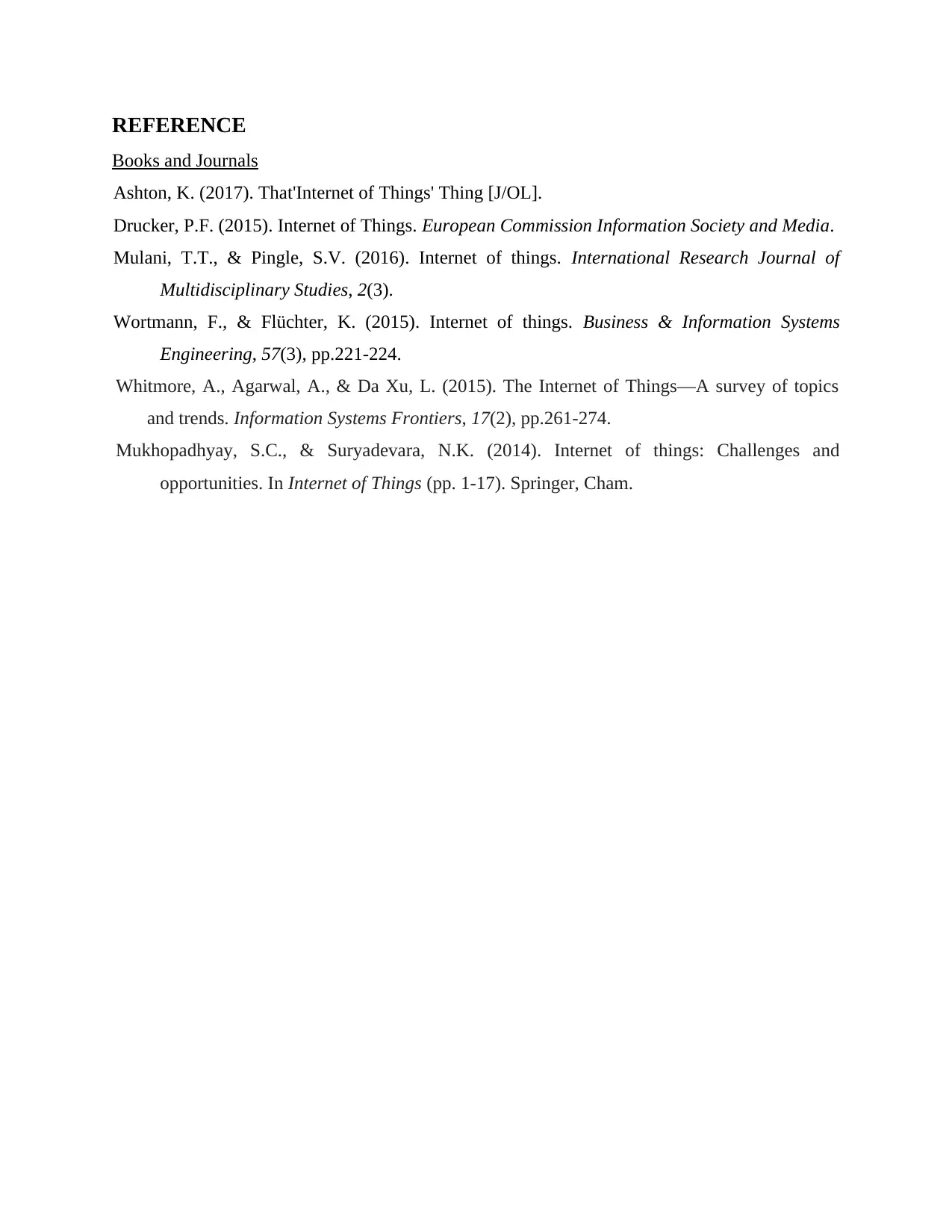
REFERENCE
Books and Journals
Ashton, K. (2017). That'Internet of Things' Thing [J/OL].
Drucker, P.F. (2015). Internet of Things. European Commission Information Society and Media.
Mulani, T.T., & Pingle, S.V. (2016). Internet of things. International Research Journal of
Multidisciplinary Studies, 2(3).
Wortmann, F., & Flüchter, K. (2015). Internet of things. Business & Information Systems
Engineering, 57(3), pp.221-224.
Whitmore, A., Agarwal, A., & Da Xu, L. (2015). The Internet of Things—A survey of topics
and trends. Information Systems Frontiers, 17(2), pp.261-274.
Mukhopadhyay, S.C., & Suryadevara, N.K. (2014). Internet of things: Challenges and
opportunities. In Internet of Things (pp. 1-17). Springer, Cham.
Books and Journals
Ashton, K. (2017). That'Internet of Things' Thing [J/OL].
Drucker, P.F. (2015). Internet of Things. European Commission Information Society and Media.
Mulani, T.T., & Pingle, S.V. (2016). Internet of things. International Research Journal of
Multidisciplinary Studies, 2(3).
Wortmann, F., & Flüchter, K. (2015). Internet of things. Business & Information Systems
Engineering, 57(3), pp.221-224.
Whitmore, A., Agarwal, A., & Da Xu, L. (2015). The Internet of Things—A survey of topics
and trends. Information Systems Frontiers, 17(2), pp.261-274.
Mukhopadhyay, S.C., & Suryadevara, N.K. (2014). Internet of things: Challenges and
opportunities. In Internet of Things (pp. 1-17). Springer, Cham.
Paraphrase This Document
Need a fresh take? Get an instant paraphrase of this document with our AI Paraphraser
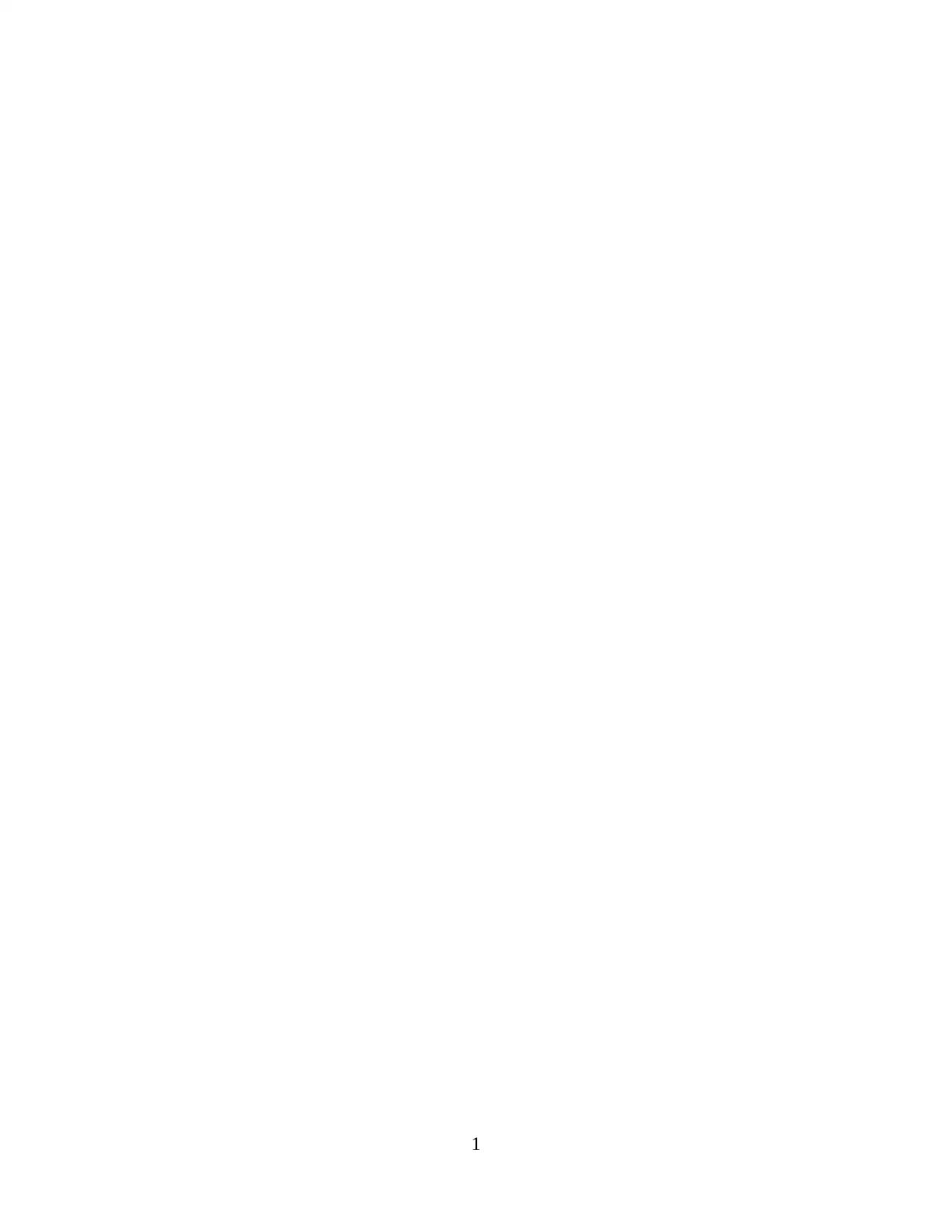
1
1 out of 8
Related Documents
Your All-in-One AI-Powered Toolkit for Academic Success.
+13062052269
info@desklib.com
Available 24*7 on WhatsApp / Email
![[object Object]](/_next/static/media/star-bottom.7253800d.svg)
Unlock your academic potential
© 2024 | Zucol Services PVT LTD | All rights reserved.





